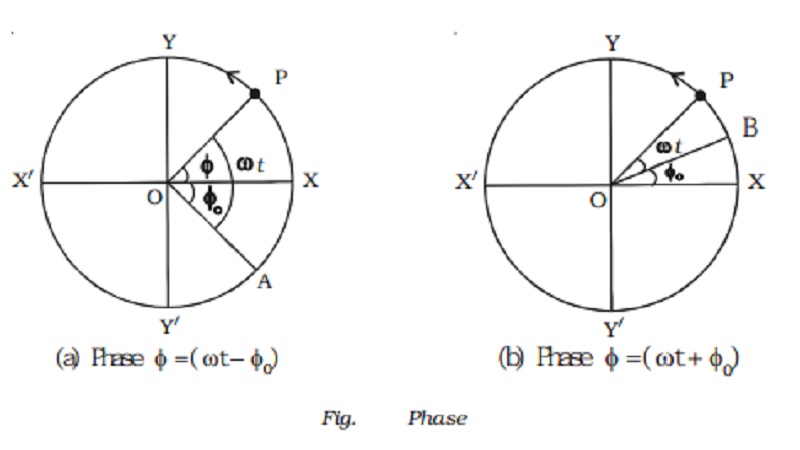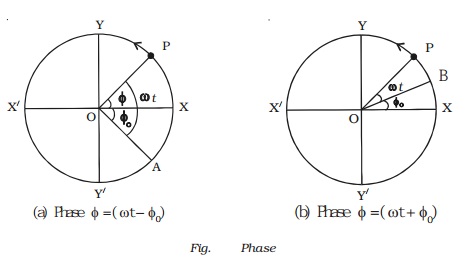Chapter: 11th 12th std standard Class Physics sciense Higher secondary school College Notes
Important terms in simple harmonic motion

Important terms in
simple harmonic motion
(i) Time period
The time taken by a particle to complete one
oscillation is called the time period T.
In the Fig., as the particle P completes one
revolution with angular velocity ω, the foot of the perpendicular N drawn to the vertical diameter
completes one vibration. Hence T is
the time period .
Then ω = 2
π/T or T = 2π / ω
The displacement
of a particle executing simple harmonic motion may be expressed as
y(t) = a sin ( 2
π / T ) t ...(1)
and y(t) = a cos ( 2 π/T ) t ...(2)
where T represents the time period, a
represents maximum displacement (amplitude).
These functions repeat when t is replaced by
(t + T).
y (t + T) = a sin [2 π/T (t + T) ]...(3)
= a sin [2 π t/ T + 2 π ]
= a sin ( 2
π t/ T ) = y (t)
In general y (t + nT) = y (t )
Above functions
are examples of periodic function with time period T. It is clear that the
motion repeats after a time T = 2π / ω where ω is the angular frequency of the
motion. In one revolution, the angle covered by a particle is 2π in time T.
ii. Frequency and angular frequency
The number of
oscillations produced by the body in one second is known as frequency. It is
represented by n. The time period to complete one oscillation is 1 / n .
T = 1 n shows the time period is the
reciprocal of the frequency. Its unit is hertz. ω = 2π n, is called as angular
frequency. It is expressed in rad s−1.
iii. Phase
The phase of a
particle vibrating in SHM is the state of the particle as regards to its
direction of motion and position at any instant of time. In the equation y = a
sin (ωt + φo) the term (ωt + φo) = φ, is known as the
phase of the vibrating particle.
Epoch
It is the
initial phase of the vibrating particle (i.e) phase at t = 0. ∴
φ = φo (∵ φ = ωt + φo) The phase of a vibrating
particle changes with time but the epoch is phase constant.

1.If the
particle P starts from the position X, the phase of the particle is Zero.
2.Instead of
counting the time from the instant the particle is at X, it is counted from the
instant when the reference particle is at A (Fig. a) . Then ang XO P = (ωt − φo).
Here (ωt − φo)
= φ is called the phase of the vibrating particle. (−φo) is initial
phase or epoch.
3.If the time is
counted from the instant the particle P is above X (i.e) at B, [Fig. b] then
(ωt + φo) = φ. Here (+φo) is the initial phase.
Phase difference
If two vibrating particles executing SHM with same time period,
cross their respective mean positions at the same time in the same direction,
they are said to be in phase.
If the two vibrating
particles cross their respective mean position at the same time but in the opposite direction, they are said to be
out of phase (i.e they have a phase difference of π).
If the vibrating motions are represented by
equations
y1 = a sin ωt and
y2 = a sin (ωt − φ)
then the phase
difference between their phase angles is equal to the phase difference between
the two motions.
∴
phase difference = ωt − φ − ωt = −φ negative sign indicates that the second
motion lags behind the first.
If y2 = a sin
(ωt + φ),
phase difference
= ωt + φ − ωt = φ
Here the second
motion leads the first motion.
We have
discussed the SHM without taking into account the cause of the motion which can
be a force (linear SHM) or a torque (angular SHM).
Some examples of SHM
1. Horizontal and vertical oscillations of a
loaded spring.
2. Vertical oscillation of water in a U−tube
3. Oscillations of a floating cylinder
4. Oscillations of a simple pendulum
5. Vibrations of the prongs of a tuning fork.
Related Topics